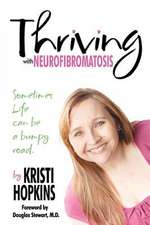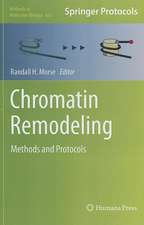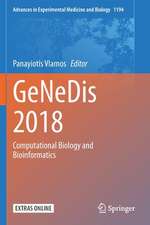Organogenetic Gene Networks: Genetic Control of Organ Formation
Editat de James Castelli-Gair Hombría, Paola Bovolentaen Limba Engleză Hardback – 6 sep 2016
| Toate formatele și edițiile | Preț | Express |
|---|---|---|
| Paperback (1) | 989.16 lei 38-44 zile | |
| Springer International Publishing – 13 iun 2018 | 989.16 lei 38-44 zile | |
| Hardback (1) | 1014.12 lei 38-44 zile | |
| Springer International Publishing – 6 sep 2016 | 1014.12 lei 38-44 zile |
Preț: 1014.12 lei
Preț vechi: 1067.49 lei
-5% Nou
Puncte Express: 1521
Preț estimativ în valută:
194.04€ • 202.62$ • 160.24£
194.04€ • 202.62$ • 160.24£
Carte tipărită la comandă
Livrare economică 12-18 aprilie
Preluare comenzi: 021 569.72.76
Specificații
ISBN-13: 9783319427652
ISBN-10: 3319427652
Pagini: 447
Ilustrații: VI, 376 p. 56 illus. in color.
Dimensiuni: 155 x 235 x 25 mm
Greutate: 0.87 kg
Ediția:1st ed. 2016
Editura: Springer International Publishing
Colecția Springer
Locul publicării:Cham, Switzerland
ISBN-10: 3319427652
Pagini: 447
Ilustrații: VI, 376 p. 56 illus. in color.
Dimensiuni: 155 x 235 x 25 mm
Greutate: 0.87 kg
Ediția:1st ed. 2016
Editura: Springer International Publishing
Colecția Springer
Locul publicării:Cham, Switzerland
Cuprins
1- Models for studying Organogenetic gene networks in the 21st century
James Castelli-Gair Hombría and Paola Bovolenta
2- Organogenesis of the C. elegans vulva and control of cell fusion
Nathan Weinstein and Benjamin Podbilewicz
3- Advances in understanding the generation and specification of unique neuronal sub-types from Drosophila neuropeptidergic neurons
Stefan Thor and Douglas W. Allan
4- Fast and Furious 800. The retinal determination gene network in Drosophila.
Fernando Casares and Isabel Almudi
5- Genetic control of salivary gland tubulogenesis in Drosophila
Clara Sidor and Katja Röper
6- Organogenesis of the Drosophila respiratory system
Rajprasad Loganathan, Yim Ling Cheng, Deborah J. Andrew
7- Organogenesis of the zebrafish kidney
George Chang, Richard W. Naylor, and Alan J. Davidson
8- Morphogenetic mechanisms of inner ear development
Berta Alsinaand Andrea Streit
9- Vertebrate eye gene regulatory networks
Juan R. Martinez-Morales
10- Vertebrate eye evolution
Juan R. Martinez-Morales and Annamaria Locascio
11- Principles of early vertebrate forebrain formation
Florencia Cavodeassi, Tania Moreno-Mármol, Maria Hernandez-Bejarano and Paola Bovolenta
12- Control of organoganesis by Hox genes
James Castelli-Gair Hombría, Carlos Sánchez-Higeras and Ernesto Sánchez-Herrero
Index
James Castelli-Gair Hombría and Paola Bovolenta
2- Organogenesis of the C. elegans vulva and control of cell fusion
Nathan Weinstein and Benjamin Podbilewicz
3- Advances in understanding the generation and specification of unique neuronal sub-types from Drosophila neuropeptidergic neurons
Stefan Thor and Douglas W. Allan
4- Fast and Furious 800. The retinal determination gene network in Drosophila.
Fernando Casares and Isabel Almudi
5- Genetic control of salivary gland tubulogenesis in Drosophila
Clara Sidor and Katja Röper
6- Organogenesis of the Drosophila respiratory system
Rajprasad Loganathan, Yim Ling Cheng, Deborah J. Andrew
7- Organogenesis of the zebrafish kidney
George Chang, Richard W. Naylor, and Alan J. Davidson
8- Morphogenetic mechanisms of inner ear development
Berta Alsinaand Andrea Streit
9- Vertebrate eye gene regulatory networks
Juan R. Martinez-Morales
10- Vertebrate eye evolution
Juan R. Martinez-Morales and Annamaria Locascio
11- Principles of early vertebrate forebrain formation
Florencia Cavodeassi, Tania Moreno-Mármol, Maria Hernandez-Bejarano and Paola Bovolenta
12- Control of organoganesis by Hox genes
James Castelli-Gair Hombría, Carlos Sánchez-Higeras and Ernesto Sánchez-Herrero
Index
Notă biografică
James Castelli-Gair Hombría
Andalusian Centre for Developmental Biology (CABD)
Paola Bovolenta
Center for Molecular Biology Severo Ochoa, CSIC-UAM and CIBERER, Madrid, Spain
Textul de pe ultima copertă
All animals, including humans, derive from a single cell, which possesses all the genetic instructions needed to define how the animal will look like. However, during development, the millions of cells that derive from the zygote will only select part of this genetic information to give rise to the various organs of the body. The coordination of different cell behaviours during development results in the formation of specialized tissues and organs giving rise to highly adapted animals. This book provides an overview of how this diversification is achieved during organ formation and how it may have evolved. Conserved cellular processes are presented using examples from selected vertebrate and invertebrate species that illustrate how developmental biologists are solving the complex puzzle of organ formation. This volume is aimed to students, researchers and medical doctors alike who want to find a simple but rigorous introduction on how gene networks control organ formation.
Caracteristici
A unique account of the development of gene networks written by some of the world’s leading experts in the field
A unique description of disease development as a result of faulty genetic and signalling pathways
A comprehensive account of gene networks in a number of model systems
Includes supplementary material: sn.pub/extras
A unique description of disease development as a result of faulty genetic and signalling pathways
A comprehensive account of gene networks in a number of model systems
Includes supplementary material: sn.pub/extras

























